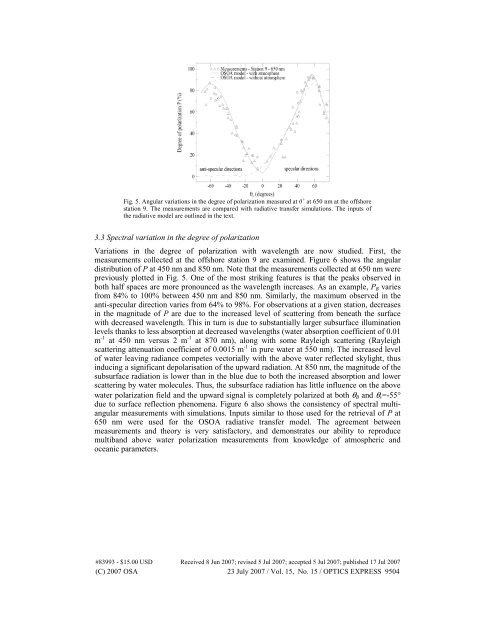Determination of biogeochemical properties of marine particles ...
Determination of biogeochemical properties of marine particles ...
Determination of biogeochemical properties of marine particles ...
Create successful ePaper yourself
Turn your PDF publications into a flip-book with our unique Google optimized e-Paper software.
Fig. 5. Angular variations in the degree <strong>of</strong> polarization measured at 0 + at 650 nm at the <strong>of</strong>fshore<br />
station 9. The measurements are compared with radiative transfer simulations. The inputs <strong>of</strong><br />
the radiative model are outlined in the text.<br />
3.3 Spectral variation in the degree <strong>of</strong> polarization<br />
Variations in the degree <strong>of</strong> polarization with wavelength are now studied. First, the<br />
measurements collected at the <strong>of</strong>fshore station 9 are examined. Figure 6 shows the angular<br />
distribution <strong>of</strong> P at 450 nm and 850 nm. Note that the measurements collected at 650 nm were<br />
previously plotted in Fig. 5. One <strong>of</strong> the most striking features is that the peaks observed in<br />
both half spaces are more pronounced as the wavelength increases. As an example, P B varies<br />
from 84% to 100% between 450 nm and 850 nm. Similarly, the maximum observed in the<br />
anti-specular direction varies from 64% to 98%. For observations at a given station, decreases<br />
in the magnitude <strong>of</strong> P are due to the increased level <strong>of</strong> scattering from beneath the surface<br />
with decreased wavelength. This in turn is due to substantially larger subsurface illumination<br />
levels thanks to less absorption at decreased wavelengths (water absorption coefficient <strong>of</strong> 0.01<br />
m -1 at 450 nm versus 2 m -1 at 870 nm), along with some Rayleigh scattering (Rayleigh<br />
scattering attenuation coefficient <strong>of</strong> 0.0015 m -1 in pure water at 550 nm). The increased level<br />
<strong>of</strong> water leaving radiance competes vectorially with the above water reflected skylight, thus<br />
inducing a significant depolarisation <strong>of</strong> the upward radiation. At 850 nm, the magnitude <strong>of</strong> the<br />
subsurface radiation is lower than in the blue due to both the increased absorption and lower<br />
scattering by water molecules. Thus, the subsurface radiation has little influence on the above<br />
water polarization field and the upward signal is completely polarized at both θ B and θ v =-55°<br />
due to surface reflection phenomena. Figure 6 also shows the consistency <strong>of</strong> spectral multiangular<br />
measurements with simulations. Inputs similar to those used for the retrieval <strong>of</strong> P at<br />
650 nm were used for the OSOA radiative transfer model. The agreement between<br />
measurements and theory is very satisfactory, and demonstrates our ability to reproduce<br />
multiband above water polarization measurements from knowledge <strong>of</strong> atmospheric and<br />
oceanic parameters.<br />
#83993 - $15.00 USD Received 8 Jun 2007; revised 5 Jul 2007; accepted 5 Jul 2007; published 17 Jul 2007<br />
(C) 2007 OSA 23 July 2007 / Vol. 15, No. 15 / OPTICS EXPRESS 9504
















